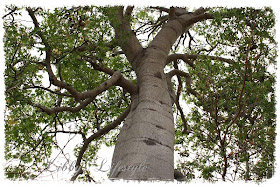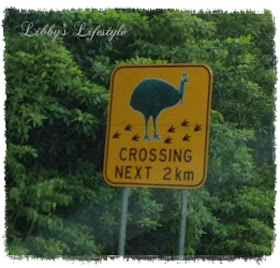Part 2.
In the morning, we rise to the sound of more gentle rain. A welcome respite from the heat but a threat to the rising humidity.
Outside our Pioneer Hut, nature breakfasts in the cool air.
We climb to the top of the bluff and gain a view which emphasises our insignificance in this land which stretches on and on.
Our tour today is to a lava tube where the roof has collapsed.
The land outside the lava tube mouth is hot and dry.
Boab trees, ancient and magnificent, shade our way.
Cicadas have left their skins and now reverberate shrilly as they seek a mate. The US visitors on our tour are fascinated.
We begin our descent. Small, white native flowers pop through the leaf litter.
The collapsed roof of the tube creates a cool, moist environment which allows rain forest species to lay claim. The temperature drops. And we are in awe.
As we move further into the tube and look back, the roof collapse becomes plainly evident.
We move on to explore the largest of the tubes. It stretches before us, cathedral like.
 |
| But no TV to be found. |
The tubes were formed because of the way the lava cooled. The enormous length of the tubes is a result of the low, steady slope which allowed to lava to flow on and on and on, slowly cooling across the landscape.
But it is time to move on. We must head east to Miss Betty.
We leave the dry western land. A dingo bids us farewell. MLP tries to stare him out (from the safety of the car) but the dingo wins. This is his territory.
We begin to encounter waterfalls, Millstream Falls.
And rain forests with strange alien like trees.
 |
| But still no T ... |
We visit Ravenshoe and sip great Mareeba coffee in a cafe wonderfully preserved and reminiscent of Collins' Cafe in Nambour in my youth.
Then, after visiting Miss Betty and my older-and-wiser sister and her brood, and, of course, delivering the tee pees, we begin to drive south.
The rains have begun and my favourite mountains are shrouded in cloud.
We drop into cassowary country to see if we can catch a glimpse of these elusive birds, but to no avail. Signs of all varieties warn us of their presence.
So they are obviously here ... somewhere?
In our five days of touring, the most bizarre sight we encounter is this ...
It seems the heat and humidity are too much for some!
In just a couple of weeks we will leave North Queensland and begin our trip south to MLP's new posting and our new life for the next three years and, hopefully, more road trips to new places.
Have you seen the elusive FNQ cassowary?
Have you a favourite road trip to share?
Thanks for reading my blog post. I'd love it if you left a comment below for me to read.



















